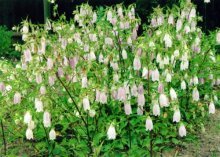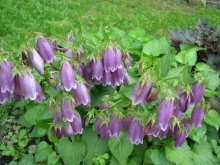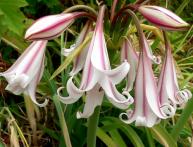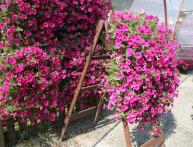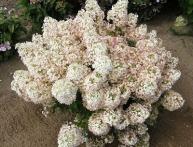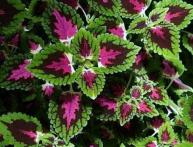What are the types of bells and how are they grown?
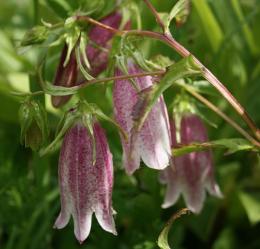
How many poetic lines, songs, and paintings are dedicated to this marvelous flower! And he still modestly bows his tender head before admiring glances. Moreover, a huge number of shades, shapes, sizes and even types of this flower are known. One of the most interesting is the dotted bell.
Content:
- Description of the dotted bell
- Features of growing through sowing
- Features of propagation by dividing the bush
Description of the dotted bell
This plant belongs to bellflower family, very common in temperate countries. It blooms all summer and even early autumn. Bellflower gets its name from the crimson speckles on the white petal visible from inside the flower. The peculiarity of the flower’s shape is that it resembles a blown barrel and tapers to petal blades.
The flower consists of 5 connected petals, forming a bell-like corolla. The bell also has 10 green cloves at the flower stem. 5 of them are raised up, and the rest are lowered down.
Hanging flowers reach 4 centimeters and are collected in lush inflorescences. The lower leaves are on cuttings. The upper ones do not have this part, so they are classified as sessile. They have very hard fluff, which is very noticeable when you touch it.
Varieties of this bell are bred in different colors:
- pink
- blue
- burgundy
- white
- deep blue
The popularity of the dotted bell is increasing due to its variety and unpretentiousness.
- Thus, the Otello variety is rich in color pigments. That's why even its sheets are painted. They are characterized by a brown color. 'Kent Bell' has very large bright blue flowers and a stem that grows over 70cm.
- Recently, the “Cherry Bells” variety with milky petal tips, a pink base and many speckles of red throughout the flower has been in great demand. He is short, only about half a meter. Breeders promise to soon release terry variations of this variety.
- Many gardeners like the double dotted bell, the so-called double bell. In this form, additional petals are formed from the stamens.
Terry as a characteristic feature of this bell is not very persistently preserved. Its availability may vary due to climate, weather and growing conditions. And the age of the plant and very hot weather contribute to the preservation of terry. Young plants are least likely to produce double flowers.
Certainly, some of the varieties This bell is distinguished by its capriciousness. But among them there are sure to be many persistent plants that can decorate any garden, no matter where it is.
Features of growing through sowing
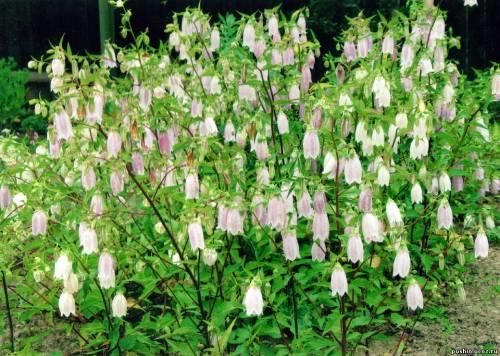
Growing bellflower is not the most carefree activity. After all, this flower needs scrupulous care.
It all starts with sowing flowers. Its seeds are not just small, but similar to dust. For their germination and subsequent development, they need a lot of light. Therefore, the place for sowing or installing a box with seedlings must be selected in advance, taking this requirement into account.
To get early production, you need to sow the seeds in special boxes. You need to pour light soil into them, sprinkle it with a layer of sand, on top of which scatter the seeds.They do not need to be immersed in the ground, but only sprayed with water and covered with polyethylene.
When will they appear shoot loops, the film can be removed and the box covered again at night. This will help harden the seedlings. When watering, you need to be very careful, because under a strong stream of water, fragile sprouts can break and the roots can be washed away.
At the same time, you need to make sure that the soil does not dry out, otherwise the seedlings will die. When 3 true leaves appear, it is advisable to pick the seedlings. Plants taken out of the ground are planted in other containers, and the remaining ones are slightly buried in the ground.
If you neglect this stage, the punctate bell will develop much worse. Starting in June, seedlings can be transplanted into a flower bed. At the end of summer, the bluebells will bloom in full bloom.
Growing through seeds is a very painstaking process. But it allows you to sow rare varieties and even develop your own.
Features of propagation by dividing the bush
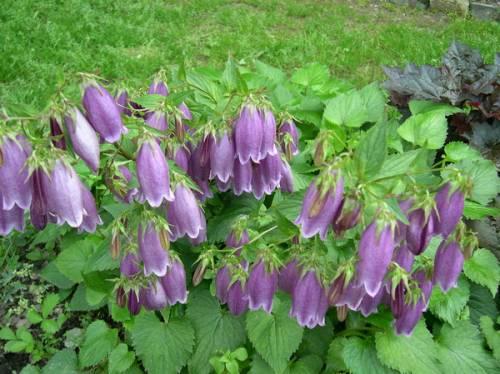
Very often this type of bell is sold in pots or as seedlings. You can also divide the bush yourself - in early spring or autumn, after flowering has ended. In this case, you need to dig up the bush with a shovel and separate part of it with your hands.
When planting a flower, it is important to follow a number of simple requirements. Since its shoots grow very rapidly underground, it is necessary to limit their movement. Otherwise, it will quickly cover the entire flowerbed. For this purpose, plastic or metal tapes are suitable, which are used to ring the slopes of the dug hole. Then the bell will spread more slowly.
The dotted bell develops freely in well-lit areas. And the shadow leads to a deterioration in its growth and even to extinction.
The flower likes light hygroscopic soil.But during active growth, watering should be limited so that the plant does not stretch and break under its own weight. At the end of flowering, the plant enters a dormant phase, shedding its leaves. To ensure that the flowerbed continues to look beautiful, you should make sure in advance that other plants, such as ground cover, grow under the bell.
The fact is that this bell will get along well even with aggressive replantings such as intensively developing sedums. To achieve a greater aesthetic effect, you can choose thickeners that will not bloom at the same time as the bell, but will do so before or after it. Faded bells are removed.
There are no too strict rules in growing bellflower. And if you follow the simple minimum of these requirements, then your flowerbed or hill will be transformed into a lush cloud during its flowering.
An interesting video about the most delicate flowers - bells:
Interesting information about the vegetable garden

